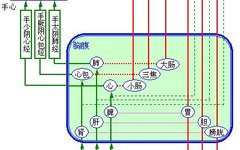The meridians are the pathways that determine life and death, address numerous ailments, and regulate deficiency and excess; they must remain unobstructed!
In the practice of Traditional Chinese Medicine (TCM) for health maintenance, the most important aspect is not merely learning moxibustion, but understanding your own meridians and acupoints. If an organ feels uncomfortable, stimulating the related meridian acupoint will bring relief.
If a certain area is painful, it is certainly due to stagnation in the meridian acupoint associated with that area. You can press, tap, needle, moxibust, cupping, or perform guasha until the pain subsides!
Diagram and Explanation of the Twelve MeridiansHand Taiyin Lung Meridian: Begins at the middle jiao (stomach area), descends to connect with the large intestine, then follows the stomach’s upper orifice, passes through the diaphragm, and reaches the lungs. From the lung system—trachea, throat—it exits under the armpit, descends along the inner side of the upper arm, through the Hand Shaoyin and Hand Jueyin meridians, down to the elbow, following the inner side of the radius to reach the wrist (radial artery pulse), then ascends to the thenar area, following the margin to the tip of the thumb.
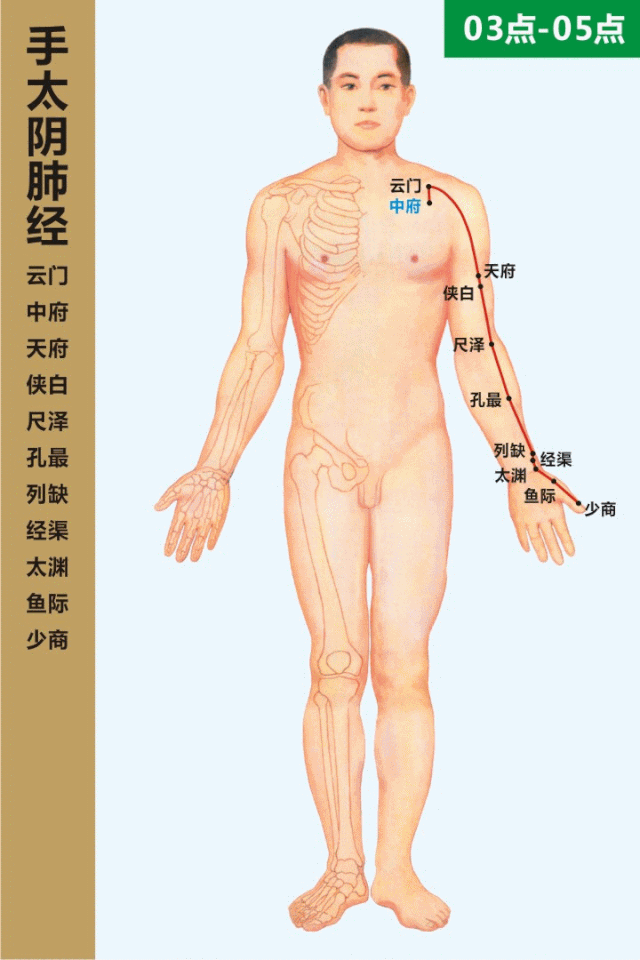
Hand Yangming Large Intestine MeridianBegins at the tip of the index finger, follows the radial side of the index finger, passes between the first and second metacarpals, reaches between the two tendons, follows the radial side of the forearm to the outer elbow, traverses the outer front of the upper arm, ascends to the shoulder, exits at the front of the shoulder peak, intersects at the neck, descends into the chest, connects with the lungs, passes through the diaphragm, and is associated with the large intestine.
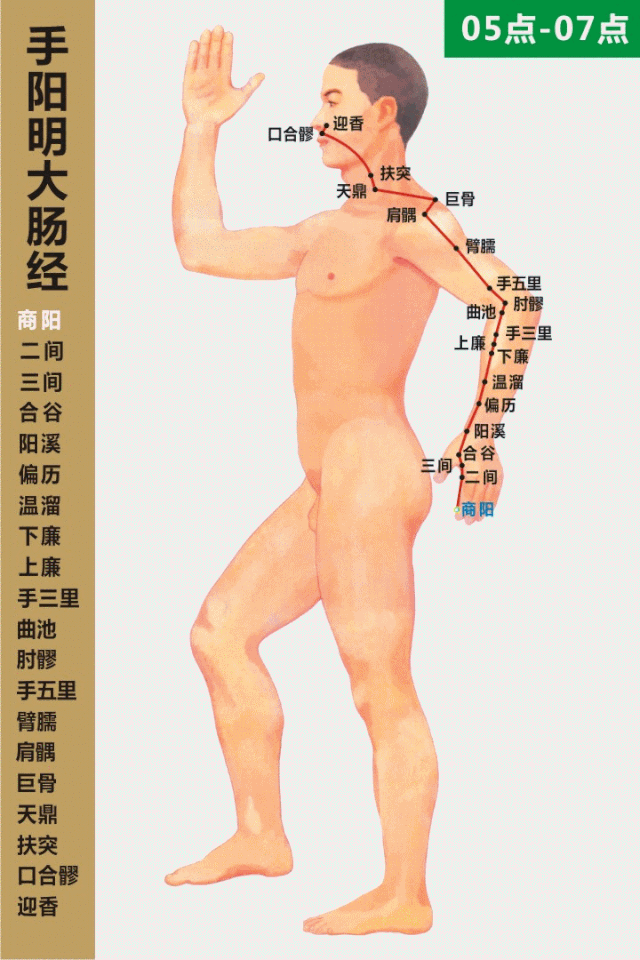
Foot Yangming Stomach MeridianStarts at the side of the nose, converges at the root of the nose, passes through the foot Taiyang meridian, descends along the outer side of the nose to the upper alveolar ridge, then returns to circle around the lips, descending to converge at the mentolabial groove; it then returns along the lower jaw to exit at the facial artery area, ascends in front of the ear, follows the zygomatic arch, and reaches the center of the forehead.
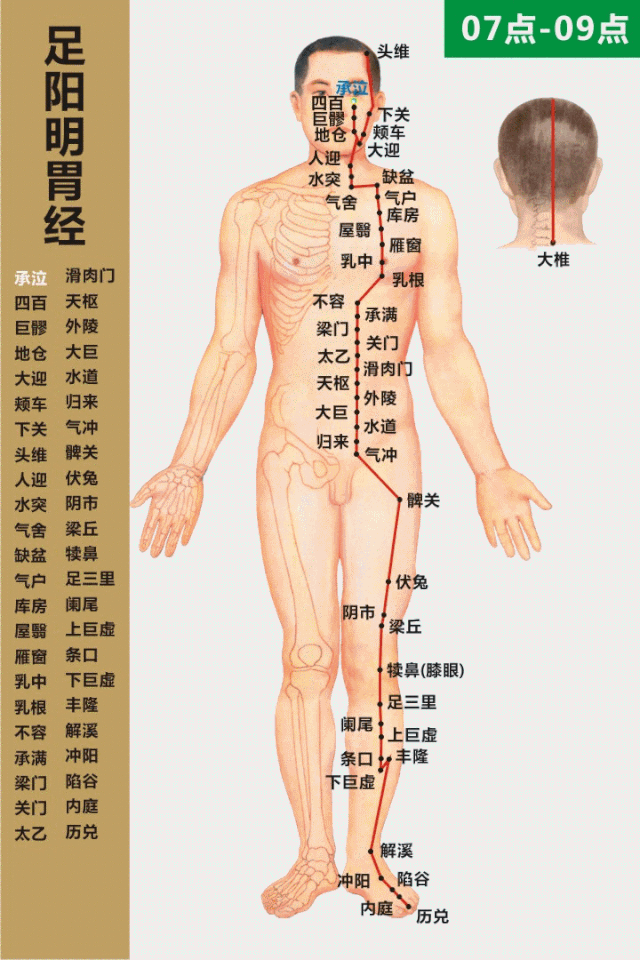
Foot Taiyin Spleen MeridianBegins at the tip of the big toe, follows the inner side of the big toe, passes through the navicular bone, ascends to the front of the inner ankle, follows the inner side of the lower leg along the tibia, reaches the front of the inner thigh, ascends to the abdomen, passes through the diaphragm, alongside the esophagus, connects to the root of the tongue, and spreads under the tongue.
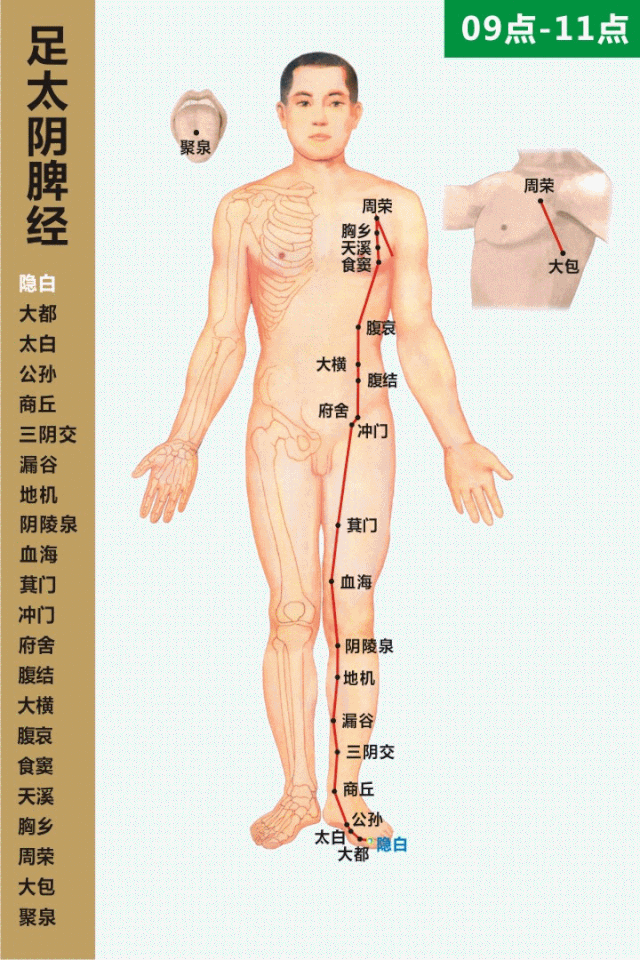
Hand Shaoyin Heart MeridianBegins at the heart, then connects to the heart and its associated organs, descends through the diaphragm, and connects to the small intestine.
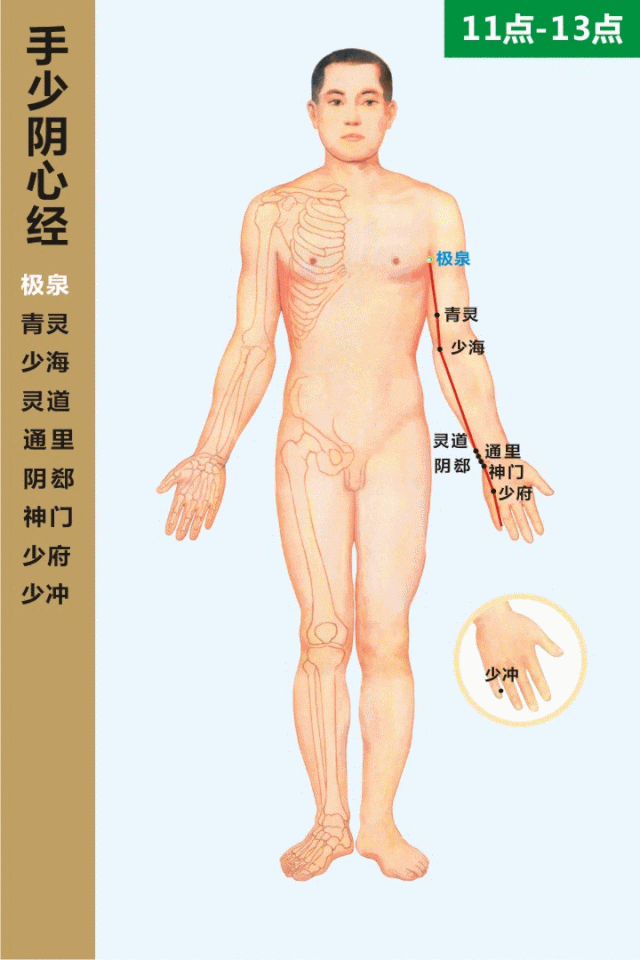
Hand Taiyang Small Intestine MeridianBegins at the outer side of the little finger, follows the ulnar side of the palm, ascends to the wrist, exits at the ulnar styloid, follows the ulnar side, exits at the inner elbow between the humerus and the ulnar olecranon, ascends along the outer back of the upper arm, exits at the shoulder joint, circles the scapula, intersects at the shoulder, reaches the chest, connects to the heart, follows the esophagus, passes through the diaphragm, and reaches the stomach, connecting to the small intestine.
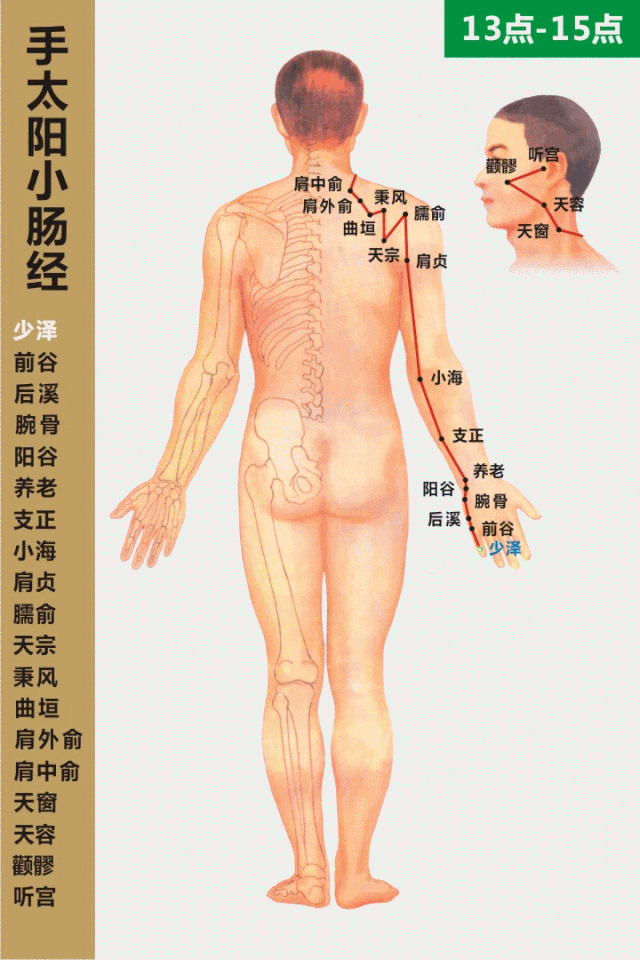
Foot Taiyang Bladder MeridianBegins at the inner corner of the eye, ascends to the forehead, and converges at the top of the head.
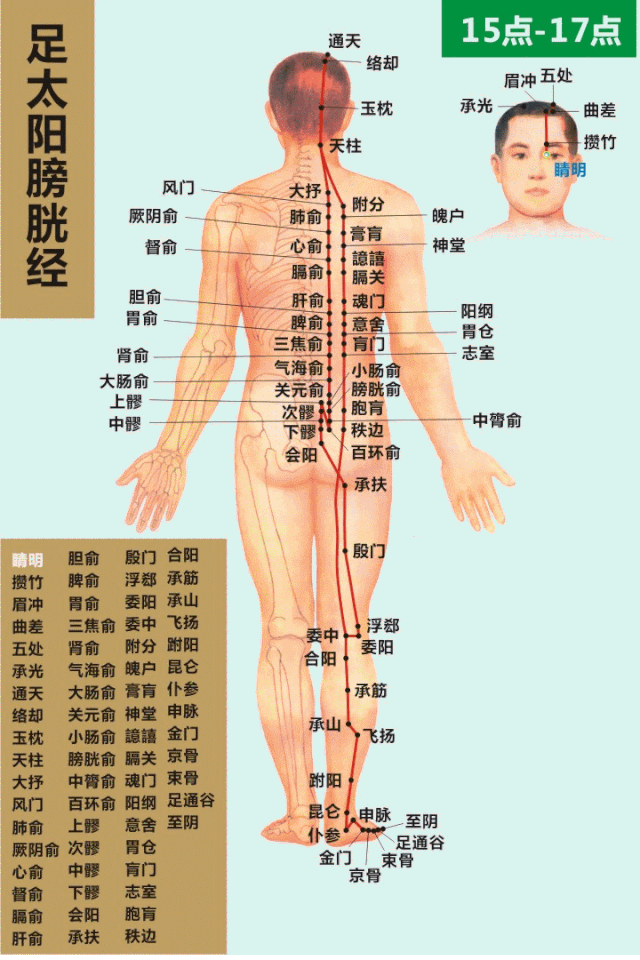
Foot Shaoyin Kidney MeridianThis meridian is associated with the treatment of conditions related to the “kidneys”: oral heat, dry tongue, swollen throat, qi counterflow, dry and painful throat, etc.
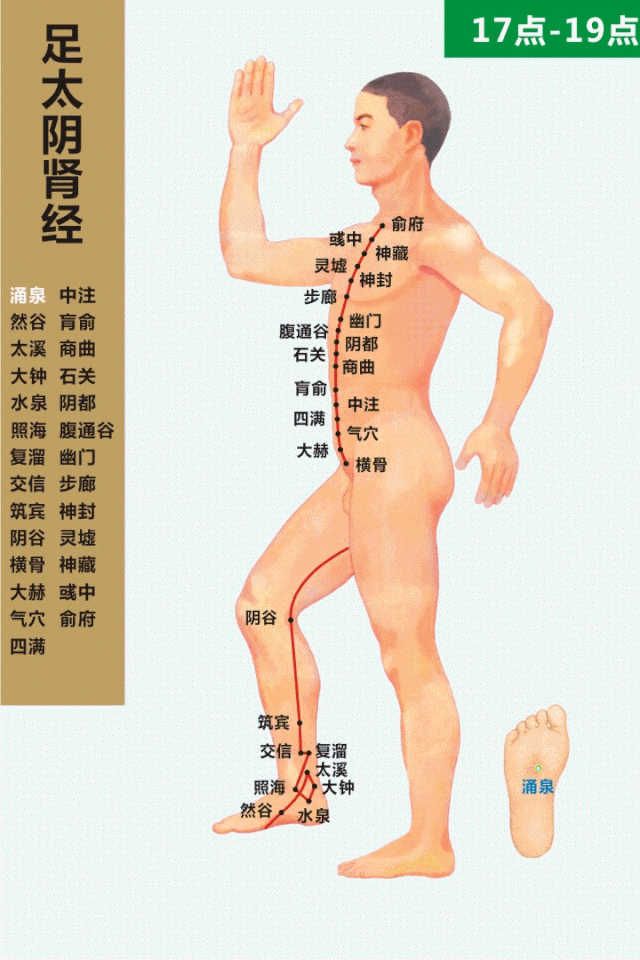
Hand Jueyin Pericardium MeridianBegins at the chest, superficially connects to the pericardium, passes through the diaphragm, chest, upper abdomen, and lower abdomen, and connects to the Sanjiao (Triple Burner).
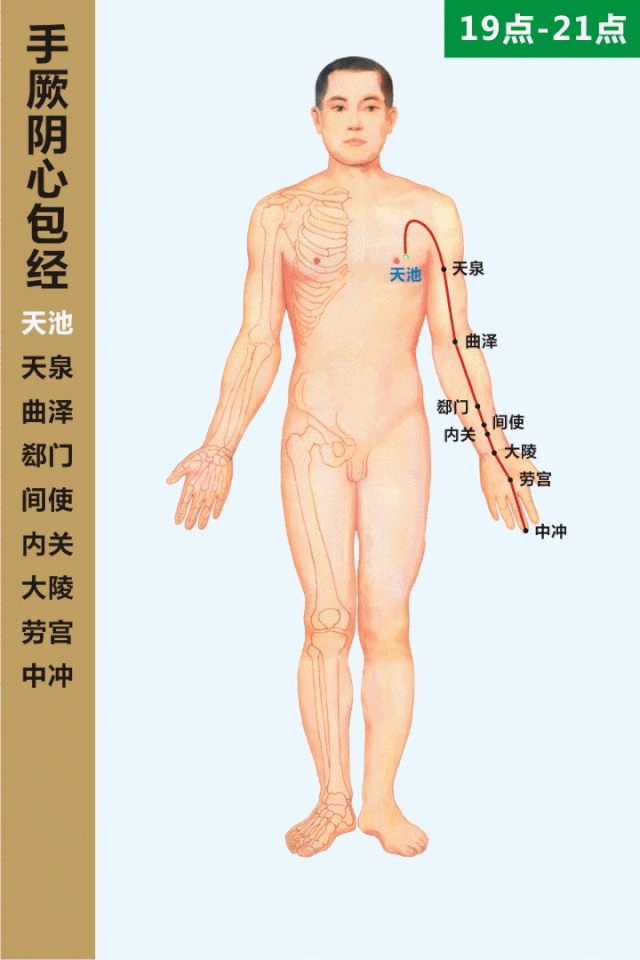
Hand Shaoyang Sanjiao MeridianBegins at the tip of the ring finger, ascends between the little and ring fingers, follows the back of the hand, exits between the two bones of the forearm, ascends through the elbow, along the outer side of the upper arm, ascends through the shoulder, intersects with the back of the foot Shaoyang meridian, reaches the chest, distributes in the zhong (middle) area, spreads to the pericardium, passes through the diaphragm, and widely connects to the upper, middle, and lower Sanjiao.
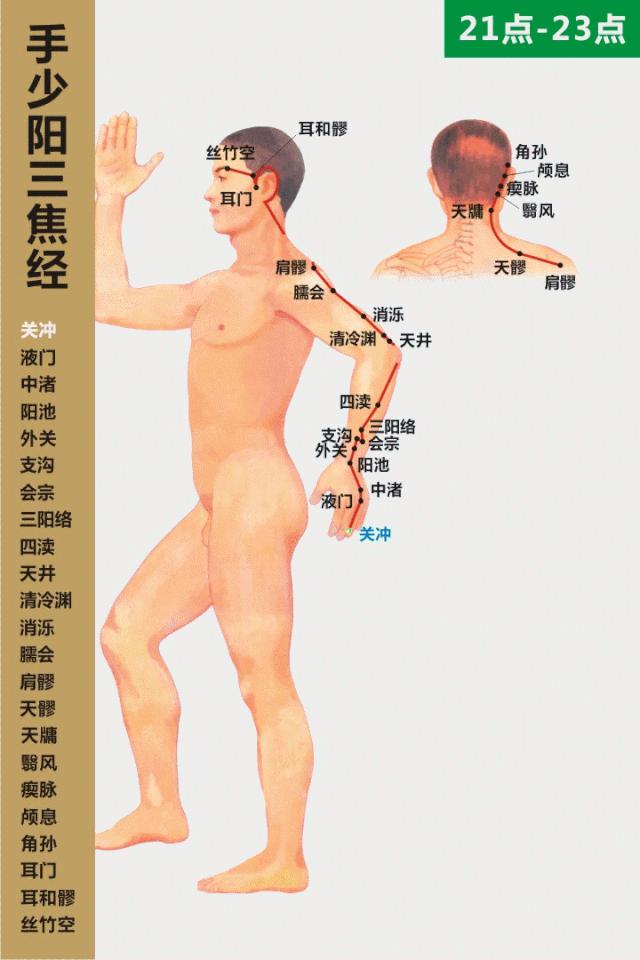
Foot Shaoyang Gallbladder MeridianBegins at the outer corner of the eye, ascends to the forehead, descends behind the ear, along the neck, follows the Hand Shaoyang Sanjiao meridian, retreats at the shoulder, intersects with the Hand Shaoyang Sanjiao meridian, and reaches the chest.
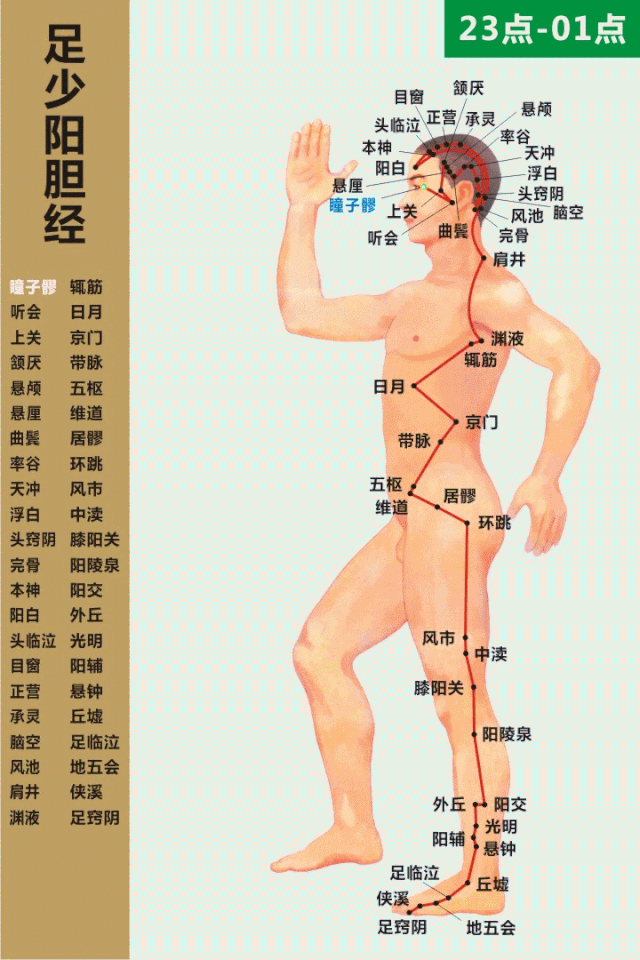
Foot Jueyin Liver MeridianBegins at the back of the big toe, follows the inner side of the foot, one inch from the inner ankle, ascends along the inner side of the lower leg, intersects with the Foot Taiyin Spleen Meridian eight inches from the inner ankle, ascends along the inner side of the thigh, reaches the pubic area, encircles the area, and reaches the lower abdomen, alongside the stomach, connecting to the liver.
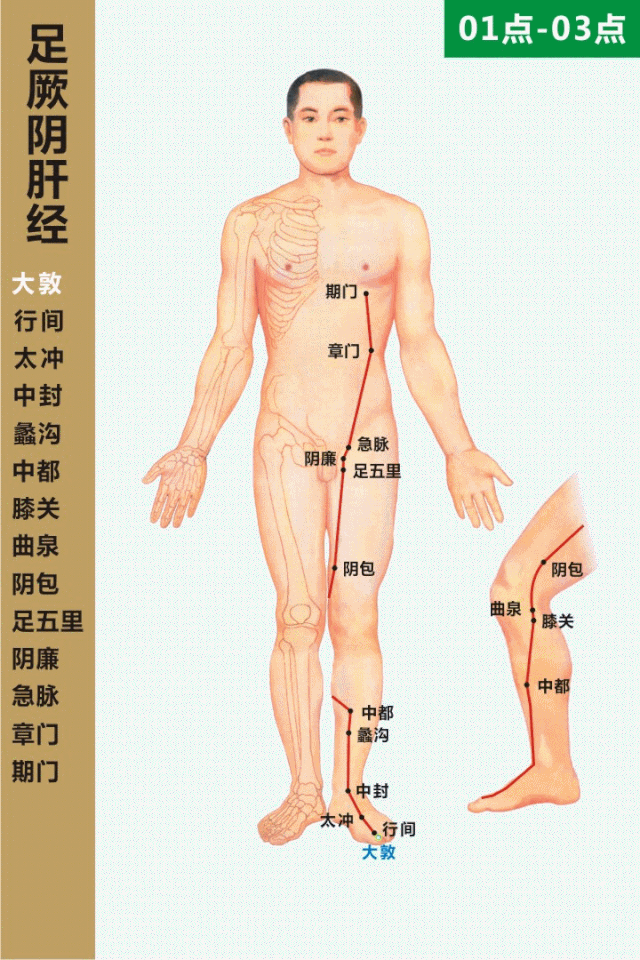
1. The Ren Meridian is located at the front of the chest; if the heart and spleen-stomach are obstructed, it can lead to aging.
2. The Du Meridian runs along the spine, supervising the flow of qi and blood; the five organs and six bowels are governed by the Du Meridian, corresponding to areas of pain.
3. The Gallbladder Meridian overlaps with the pants line, causing secretion disorders and affecting the nervous system; symptoms include drowsiness, excessive sweating, fatigue, swollen armpits, and headaches; lymphatic inflammation can cause localized swelling, and yellowing of the eyes may occur.
4. The Liver Meridian corresponds to the Gallbladder Meridian, controlling circulation and secretion; symptoms include bluish skin, waist pain, dark circles under the eyes, and dysmenorrhea; dry eyes and excessive eye discharge may indicate excessive liver fire.
5. The Kidney Meridian is located behind the Liver Meridian, not far apart; it controls the secretion system, with symptoms of scanty urination and frequent urination; symptoms include bags under the eyes, wrinkles, cold feet, swollen lower limbs, anxiety, and premenstrual back pain.
6. The Kidney Meridian corresponds to the Bladder Meridian, controlling the urinary and skeletal systems; symptoms include yellow urine, bladder pain, urinary tract infections, weakness in the limbs, back pain, and difficulty sitting due to hemorrhoids.
7. The Stomach Meridian is located in front of the Gallbladder Meridian, three fingerbreadths away; symptoms include oral ulcers, swollen gums, dry mouth, bad breath, abdominal distension, and heat sensation; symptoms of belching and preference for cold foods, with dry stools that are difficult to pass.
8. The Stomach Meridian corresponds to the Spleen Meridian, controlling the immune and nervous systems; symptoms include stomach distension, belching, and gas; vomiting, unbearable pain under the ribs, varicose veins, low blood pressure, and rheumatism may also occur.
9. The index finger corresponds to the armpit of the Large Intestine Meridian, which is on the outer side of the arm; it controls digestion and the nervous system; symptoms include abdominal distension, dry mouth, shoulder and neck pain, heat in the body, hemorrhoids, and headaches.
10. The Lung Meridian runs from the chest to the thumb, located on the inner side of the arm; it controls respiration and immunity; symptoms include dehydration, sensitivity, and nasal obstruction; heat in the body, sweating, back acne, and dry phlegm may occur; cold symptoms may lead to internal emptiness.
11. The Heart Meridian runs from the chest to the little finger, located on the inner side of the arm; it controls the circulatory system; symptoms include chest tightness and headaches; irritability, insomnia, and frequent dreams, along with pain in the shoulders and chest, may occur; red eyes, flushed cheeks, dry mouth, and poor blood circulation may indicate stress.
12. The little finger corresponds to the Small Intestine Meridian, located on the outer side of the arm; it controls digestion and the nervous system; symptoms include pain in the solar plexus and ears; premenstrual abdominal distension, headaches, and back pain may occur.
13. The chest to the middle finger corresponds to the Heart Protector Meridian, located on the inner side of the arm; it controls secretion and circulation; symptoms include poor circulation and vascular diseases; rapid heartbeat and constipation, irritability, red eyes, and pain in the upper limbs may occur.
14. The ring finger to the shoulder corresponds to the Sanjiao Meridian, located on the outer side of the arm; it controls secretion and circulation; symptoms include decreased immunity and depression; fatigue and susceptibility to chronic diseases may occur.
Tips to Memorize the Twelve Meridians in One Minute:
(1)
The distribution of the twelve meridians in the head and face (details in the textbook) does not need to be memorized; just know that headaches occur.
For example: Yangming headaches occur in the forehead, Shaoyang headaches occur on both sides of the ears, Taiyang headaches occur at the back of the head, and Jueyin headaches occur at the top of the head.
Example:
A forehead area
B cheek area
C side of the head
D back of the head
E top of the head
1 Hand Yangming Meridian is distributed in ( )
2 Foot Shaoyang Meridian is distributed in ( )
Explanation: Yangming is in the forehead, so the answer for 1 is A; Shaoyang is on both sides of the ears, so the answer for 2 is C.

(2)
The distribution of the twelve meridians in the upper limbs (details in the textbook) can be remembered with six words: Tai, Jue, Shao, Yang, Shao, Tai.
In exam questions, the first three words for Yin meridians are: Tai indicates Taiyin, at the front; Jue indicates Jueyin, in the middle; Shao indicates Shaoyin, at the back. The last three words for Yang meridians are: Yang indicates Yangming, at the front; Shao indicates Shaoyang, in the middle; Tai indicates Taiyang, at the back.
To determine whether they are on the inner or outer side, just remember the Yin-Yang properties: Yin is on the inside, Yang is on the outside, meaning Yin meridians are on the inner side, and Yang meridians are on the outer side.
Example:
1 Hand Jueyin is distributed in ( )
A upper limb inner front edge
B upper limb outer front edge
C upper limb inner midline
D upper limb outer midline
E upper limb outer back edge
Explanation: Since Hand Jueyin is a Yin meridian, using the first three words “Tai, Jue, Shao,” Yin meridians are on the inner side, Jue is in the middle, so the answer should be C.
2 Hand Taiyang is distributed in ( )
A upper limb inner front edge
B upper limb outer front edge
C upper limb inner back edge
D upper limb outer midline
E upper limb outer back edge
Explanation: Since Hand Taiyang is a Yang meridian, using the last three words “Yang, Shao, Tai,” Yang meridians are on the outer side, Tai (Taiyang) is at the back, so the answer is E.

(3)
The distribution of the twelve meridians in the lower limbs (details in the textbook) follows the same pattern as the upper limbs, using “Yang, Shao, Tai.”
Example:
The meridian that follows the outer midline of the lower limb is ( )
A Foot Shaoyang Gallbladder Meridian
B Foot Shaoyin Kidney Meridian
C Foot Jueyin Liver Meridian
D Foot Taiyin Spleen Meridian
E Foot Yangming Stomach Meridian
Explanation: The outer side of the lower limb must be a Yang meridian, using “Yang, Shao, Tai,” Shao is in the middle, so the answer is A.
2 Eight inches below the lower limb: Jue, Tai, Shao (Jueyin, Taiyin, Shaoyin) 3 Eight inches above the lower limb: Tai, Jue, Shao (Taiyin, Jueyin, Shaoyin) [This is the same as the Yin meridians in the upper limbs.]
Understanding is the same as the Yin meridians in the upper limbs.
Example:
Above eight inches from the inner ankle, following the inner front edge of the lower limb is ( )
A Foot Shaoyang Gallbladder Meridian
B Foot Shaoyin Kidney Meridian
C Foot Jueyin Liver Meridian
D Foot Taiyin Spleen Meridian
E Foot Yangming Stomach Meridian
A diagram of the twelve meridians to enhance memory.
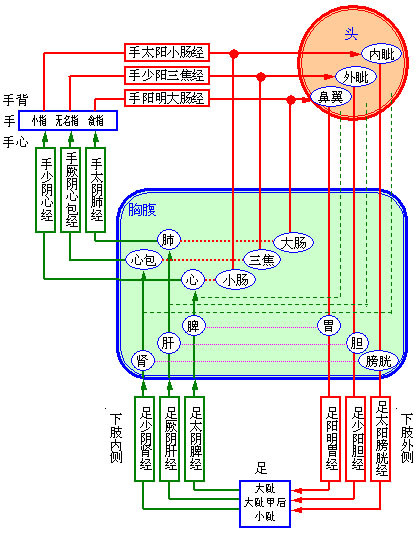
The pathways and naming conventions of the twelve meridians reflect their primary distribution areas and the organs they are associated with. Understanding and flexibly applying this knowledge will quickly help you memorize the distribution of the twelve meridians, guiding acupuncture clinical point selection and treatment.
1. The pathways of the twelve meridians can be summarized as follows:
Hand three Yin meridians run from the chest to the hands,
Hand three Yang meridians run from the hands to the head,
Foot three Yang meridians run from the head to the feet,
Foot three Yin meridians run from the feet to the abdomen (chest).
Key points for memory: The pathways of the twelve meridians can be simply summarized as “Raise your hands and stand straight, Yin rises and Yang descends.”
2. The naming conventions of the twelve meridians
|
Yang Meridians |
Yin Meridians |
||
|
Foot |
Taiyang–Bladder |
Foot |
Taiyin–Spleen |
|
Yangming–Stomach |
Shaoyin–Kidney |
||
|
Shaoyang–Gallbladder |
Jueyin–Liver |
||
|
Hand |
Taiyang–Small Intestine |
Hand |
Taiyin–Lung |
|
Yangming–Large Intestine |
Shaoyin–Heart |
||
|
Shaoyang–Triple Burner |
Jueyin–Pericardium |
The names of the twelve meridians are determined based on the hands and feet, Yin and Yang, and the organs.
1. Organs
The twelve meridians have specific connections with the six organs and six bowels, represented by the terms “belong” and “connect.” The meridians that directly connect to an organ or bowel are called “belonging” and are named after that organ or bowel; the meridians that connect to the corresponding organ or bowel are called “connecting.” For example, the Hand Taiyin Lung Meridian is named after the “lung,” indicating it belongs to the lung and connects to the large intestine; the Hand Yangming Large Intestine Meridian is named after the “large intestine,” indicating it belongs to the large intestine and connects to the lung.
2. Hands and Feet
The meridians primarily distributed in the upper limbs are called “Hand… Meridian”; those primarily distributed in the lower limbs are called “Foot… Meridian.” For example, the Hand Taiyin Lung Meridian is named “Hand” indicating it is primarily distributed in the upper limb; the Foot Taiyin Spleen Meridian is named “Foot” indicating it is primarily distributed in the lower limb.
3. Yin and Yang
According to the theory of Yin and Yang, organs are Yin, and bowels are Yang; the inside is Yin, and the outside is Yang. Among the twelve meridians, those belonging to the six bowels and distributed on the outer side of the upper or lower limbs are called “Yang meridians”; those belonging to the six organs and distributed on the inner side of the upper or lower limbs are called “Yin meridians.” Furthermore, based on the conditions of Yin and Yang, they are further divided into three Yin and three Yang, namely Taiyin, Shaoyin, Jueyin, and Yangming, Shaoyang, Taiyang. Their arrangement on the inner or outer sides of the limbs is: Taiyin and Yangming at the front, Jueyin and Shaoyang in the middle, and Shaoyin and Taiyang at the back. Additionally, since “the head is the meeting of all Yang,” all six Yang meridians are distributed in the head; the three Yang meridians of the foot run from the head to the feet and also pass through the trunk. The distribution of Yang meridians in the head and trunk still follows the pattern of Yangming at the front, Shaoyang in the middle (side), and Taiyang at the back.
4. Practical Demonstration
1. Hand Taiyin Lung Meridian
First, the Hand three Yin meridians run from the chest to the hands. Second, “Hand” indicates distribution in the upper limb; “Taiyin” indicates it is located on the inner front edge of the limb; “Lung” indicates it belongs to the lung and connects to the large intestine.
Therefore, based on the pathways and naming conventions of the twelve meridians, we can deduce that the Hand Taiyin Lung Meridian runs from the chest to the hand, primarily distributed on the inner front edge of the upper limb, belonging to the lung and connecting to the large intestine.
2. Foot Shaoyang Gallbladder Meridian
First, the Foot three Yang meridians run from the head to the feet. Second, “Foot” indicates distribution in the lower limb; “Shaoyang” indicates it is located on the outer side of the limb; “Gallbladder” indicates it belongs to the gallbladder and connects to the liver.
Therefore, based on the pathways and naming conventions of the twelve meridians, we can deduce that the Foot Shaoyang Gallbladder Meridian runs from the head to the feet, primarily distributed on the outer side of the lower limb, belonging to the gallbladder and connecting to the liver.
5. Distribution of the Twelve Meridians
Lung, Large Intestine, Stomach, Spleen, Heart, Small Intestine, Bladder, Kidney, Pericardium, Sanjiao, Gallbladder, Liver, Lung
Yin, Yang, Chen, Si, Wu, Wei, Shen, You, Xu, Hai, Zi, Chou
The twelve meridians correspond to the twelve hours, making this easier to remember in clinical practice.
Appendix: “Four Sacred Heart Sources: Heaven and Man Explained: The Start and End of Meridians”
Gallbladder, Stomach, Large Intestine, Small Intestine, Sanjiao, Bladder, are called the six bowels; Liver, Heart, Spleen, Lung, Kidney, Pericardium, are called the six organs. The six organs and six bowels give rise to the twelve meridians. The Yangming Large Intestine, Taiyang Small Intestine, and Shaoyang Sanjiao are called the three Yang meridians of the hand; the Yangming Stomach, Taiyang Bladder, and Shaoyang Gallbladder are called the three Yang meridians of the foot; the Taiyin Spleen, Shaoyin Kidney, and Jueyin Liver are called the three Yin meridians of the foot; the Taiyin Lung, Shaoyin Heart, and Jueyin Pericardium are called the three Yin meridians of the hand.
The three Yang meridians of the hand run from the hand to the head. The Hand Yangming runs from the index finger, exits at Hegu, follows the inner arm, ascends to the neck, enters the lower teeth, left to right, and up to the nostrils. The Hand Taiyang runs from the little finger, along the outer side of the hand, follows the inner arm, ascends to the neck, and reaches the inner canthus of the eye. The Hand Shaoyang runs from the middle finger, follows the back of the hand, exits at the outer arm, ascends to the neck, and reaches the outer canthus of the eye. All three meridians run from the outer arm to the head, with Yangming at the front, Taiyang at the back, and Shaoyang in the middle.
The three Yang meridians of the foot run from the head to the feet. The Foot Yangming runs from the nose, follows the throat, enters the chest, descends to the breast, follows the navel, and runs along the outer side of the leg to the big toe. The Foot Taiyang runs from the inner canthus of the eye, ascends to the forehead, converges at the top of the head, descends to the neck, follows the spine, reaches the waist, passes through the buttocks, enters the popliteal fossa, exits at the outer ankle, and reaches the little toe. The Foot Shaoyang runs from the outer canthus of the eye, descends behind the ear, follows the neck, enters the chest, runs along the side of the body, exits at the outer ankle, and reaches the index finger. All three meridians run from the outer leg to the feet, with Yangming at the front, Taiyang at the back, and Shaoyang in the middle.
The three Yin meridians of the foot run from the feet to the chest. The Foot Taiyin runs from the big toe, ascends to the inner ankle, enters the abdomen, and passes through the diaphragm. The Foot Shaoyin runs from the little toe, follows the inner ankle, passes through the spine, ascends through the diaphragm, and enters the chest. The Foot Jueyin runs from the big toe, ascends to the inner ankle, reaches the lower abdomen, passes through the diaphragm, and spreads to the ribs. All three meridians run from the inner leg to the chest, with Taiyin at the front, Shaoyin at the back, and Jueyin in the middle.
The three Yin meridians of the hand run from the chest to the hands. The Hand Taiyin runs from the chest, exits under the armpit, follows the inner front edge of the arm, enters the wrist, and reaches the thumb. The Hand Shaoyin runs from the chest, exits under the armpit, follows the inner back edge of the arm, reaches the palm, and ends at the little finger. The Hand Jueyin runs from the chest, exits under the armpit, follows the inner side, enters the palm, and reaches the middle finger. All three meridians run from the inner arm to the hands, with Taiyin at the front, Shaoyin at the back, and Jueyin in the middle.
The pathways of the three Yang meridians of the hand to the head and the three Yang meridians of the foot to the feet all belong to their respective organs and connect to their corresponding organs. The three Yin meridians of the foot to the chest and the three Yin meridians of the hand to the hands all belong to their respective organs and connect to their corresponding bowels. The Hand Yangming and Hand Taiyin are interrelated, as are the Foot Yangming and Foot Taiyin, the Hand Taiyang and Hand Shaoyin, the Foot Taiyang and Foot Shaoyin, the Hand Shaoyang and Hand Jueyin, and the Foot Shaoyang and Foot Jueyin. The six Yang and six Yin meridians are distributed in the left and right hands and feet, which is referred to as the twenty-four meridians.

